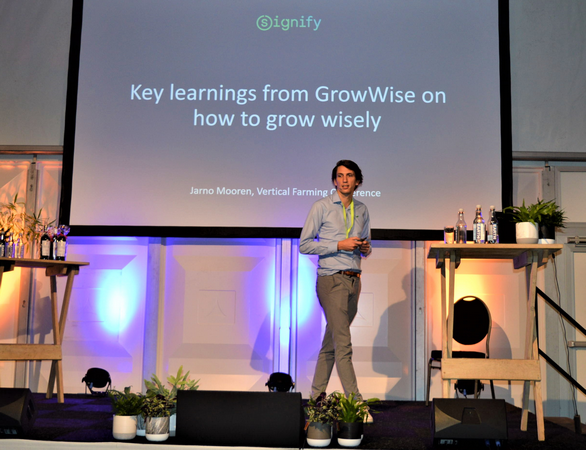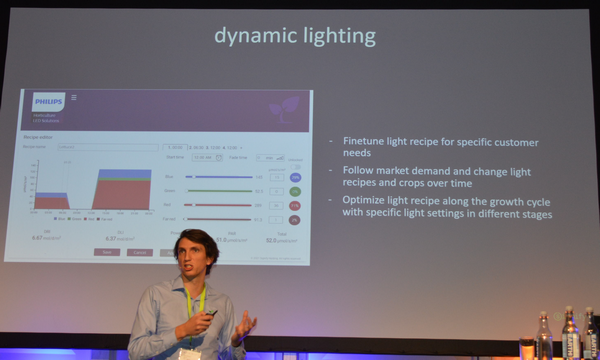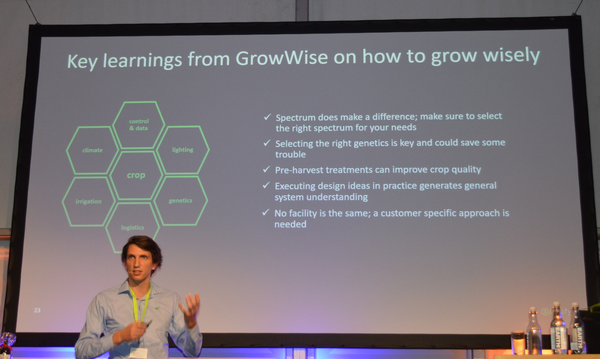In the 2021 edition of the Vertical Farming Conference, researchers and industry members presented their experiences in vertical farming and research findings aimed at pushing the industry further. Among the presenters was Jarno Mooren, a plant specialist in vertical farming at Signify. Signify conducts extensive vertical farming research at its GrowWise Center in Eindhoven, the Netherlands; Jarno took the stage at the Vertical Farming Conference to present key research findings, which are summarized below.
Key finding #1: There is no one-size-fits-all light spectrum
Horticultural lighting technology has dramatically developed in the past decade, with LED advancements allowing the industry to finetune lighting strategies according to crop and prod uction system. Perhaps most importantly, growers and researchers alike were given the tools to ask a critical question: what is the best spectrum for my crop?
 Jarno Mooren
Jarno Mooren
A common theme throughout Jarno’s presentation was the uniqueness of every vertical farming facility and the need to tailor growing strategies, and light spectrum was no exception. As an example, Jarno discussed GrowWise findings pertaining to blue light and fresh weight. At higher percentages of blue light, the GrowWise research team noted a reduction in the fresh weight of lettuce. However, dry matter was increased under higher levels of blue light and is associated with higher nutritional quality and improved shelf life. While fresh weight is the main consideration in marketing leafy greens, shelf life and quality are also important, as consumers look for products that are both local and of higher quality than imported commodities.
“We’re learning that there is no Holy Grail for growing, or a one-size-fits-all approach. A grower focusing on fresh weight may want to reduce blue light. If focusing on shelf life, increase it,” Jarno explains.
Key finding #2: Genetics can make or break a system
The GrowWise Center works closely with breeders to screen varieties that will soon be introduced to the greenhouse, field agriculture, and vertical farming market. Although these growing environments are vastly different, the genetics of different varieties may allow for the adaptation of greenhouse and field varieties for vertical farming. These variety screenings allow the researchers to identify differences between varieties and develop optimized growing strategies or recipes for each.
“We’re seeing a lot of differences between crop types; we need to select the right genetics for a system rather than building a system around the genetics,” notes Jarno.

Key finding #3: Logistics and pre-harvest treatments
Another important consideration is the logistics throughout the growth cycle, such as plant density, respacing, and pre-harvest treatments. As Jarno explains, there is significant potential in applying pre-harvest coloring treatments to promote red pigmentation and improvements in nutritional quality. In greenhouse and field-based lettuce production, this color accumulation is driven by water stress, excess light, and UV wavelengths. Without these stressors in vertical farms, alternative methods must be applied such as increasing blue light output during the final days of production.
Adjusting the growing conditions during the last days of growth can also reduce the nitrate concentration and improve the antioxidant content in leafy greens prior to harvest, according to Jarno’s research.
Key finding #4: Execute design ideas to build understanding
The main advantage Signify gains from its GrowWise Center is the ability to execute design ideas, generate a general understanding of different growing systems, and determine which methods are most effective. This has become a crucial element of Signify’s interaction with vertical farms as it fosters trust and knowledge transfer.
“All crops need different growth systems and substrates, whether vine crops, strawberries, lettuce, etc. We have learned that it is very important to have a facility in which we can design and test. We wanted to design a strawberry cell, for example, so we did,” says Jarno.
Key finding #5: No facility is the same
Although the GrowWise Center has been instrumental in developing different growth recipes, Signify adopts a customer-specific approach when applying these recipes to different farms. Growth recipes consider different substrates and systems, irrigation, light, and climate, all of which vary between vertical farms. To account for this, Signify strongly focuses on knowledge translation and adaptation for different scenarios.

Key finding #6: Full control of lights is the way forward
The final point of his presentation was the importance of dynamic lighting to help vertical farms remain flexible and affect crop quality.
“With the GrowWise control system, growers can control the spectrum and intensity of the light to meet customer needs. You can follow the market demand by changing your lighting to grow new varieties or crops, or optimize the light recipe for different stages of the plant,” says Jarno.
The GrowWise Center spans 234 m2 and has eight climate-controlled rooms equipped with multilayer systems, all focused on researching crop production under varying light and climate conditions.

Signify
